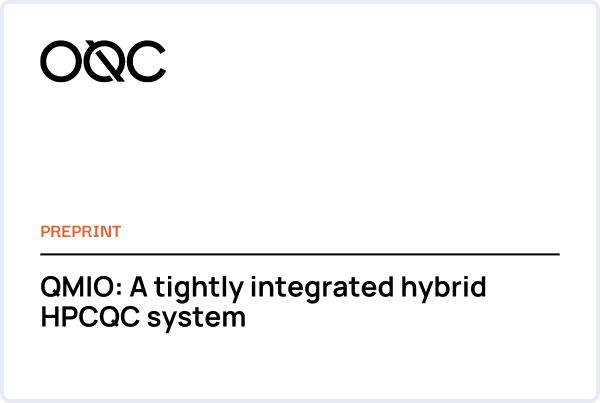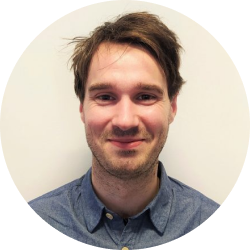
TECHNICAL BLOG
A year of QMIO: a tightly integrated hybrid HPC-QC system at Spain’s Galician Supercomputing Center
- Quantum computing has the potential to enhance existing HPC systems by accelerating the execution of specific tasks through the use of a quantum processor: addressing the need for increased computational power to solve problems currently too computationally demanding or unresolvable with classical compute alone which will bring economic benefits to end users in the near future.
- Researchers from the Galicia Supercomputing Center, FUJITSU, and OQC have developed QMIO: a state-of-the-art hybrid system that seamlessly integrates quantum computing with traditional high-performance computing (HPC) systems.
- Integrating HPC and quantum computing presents significant challenges across hardware and software; QMIO demonstrates the successful tight integration between the two systems and the work carried out explores the lessons learned during the design, implementation and operation of this new hybrid infrastructure.

Russell Rundle
QUANTUM SOFTWARE ENGINEER
Russell is a Quantum Software Engineer at Oxford Quantum Circuits, specialising in qubit control and readout calibration, system testing and benchmarking, and quantum circuit compilation. He has an academic background in verification, validation and benchmarking of quantum computers, and industry experience in software development.

George Long
SENIOR QUANTUM ENGINEER
George leads the cryogenic infrastructure team within OQC’s advanced product development group. George’s responsibilities include the specification of the cryogenic measurement infrastructure for production systems and driving long term development work towards scaling this infrastructure to support future OQC quantum computers. Prior to joining OQC, George worked at the National Physical Laboratory (NPL) across the Quantum Information Processing group and the Quantum Material and Sensors group. George was involved in multiple research projects involving the design and measurement of various quantum sensors for single particle metrology, including Josephson junction and Superconducting Quantum Interference Device (SQUID) based radio-frequency electronics, collaborating with numerous universities and national measurement institutes over the course of his tenure.

Jamie Friel
TECHNOLOGY MANAGER: QUANTUM THEORY
Jamie is responsible for building software solutions that will help build a quantum future. In particular building a bespoke quantum compiler that will allow groundbreaking problems to be solved on OQC’s hardware. Before joining OQC, Jamie worked as a software developer for a grid battery company, part of the UK’s national grid goal to bring greenhouse gas emissions to net zero by 2050.
QMIO, a state-of-the-art hybrid system that seamlessly integrates quantum computing (QC) with traditional high-performance computing (HPC) systems, has been fully operational for one year at Spain’s Galician Supercomputing Center. Developed by researchers from OQC, the Galicia Supercomputing Center, and FUJITSU, the creation of QMIO has seen some of the most challenging aspects of quantum-classical integration being addressed through close collaboration across the partnership.
In 2023, OQC, in partnership with Fujitsu, supplied a 32-qubit quantum computer to Spain’s Galician Supercomputing Center (CESGA). The partnership underscores both the global demand for British quantum expertise and the strong quantum know-how of Spain, resulting in CESGA’s state-of-the-art hybrid HPC and QC system: QMIO. The project is a key pillar of the Galician Quantum Technologies Pole, which has already attracted $30 million in investments, created jobs, and positioned Spain and Galicia as leading players in the quantum ecosystem.
This state-of-the-art deployment in Galicia, which has now been fully operational for a year, sees the creation of a new system, referred to as an HPCQC system, in which quantum computing has the potential to enhance existing HPC systems by accelerating the execution of specific tasks through the use of a quantum processor. While classical HPC systems are currently the most powerful tools we have for solving complex computational problems, the unique nature of quantum computers means that they have the future potential to offer faster solutions for some specific problems while consuming less energy and producing better quality results. In the future, quantum computing will therefore support the completion of a broader range of complex computation problems and may one day help to solve problems that are unresolvable with classical compute alone.
While quantum computers are a promising avenue for future increases in the computational power required to solve some of the world’s most challenging problems, current generation systems are still in a development stage. Known as the Noisy Intermediate-Scale Quantum (NISQ) era, the current generation of quantum computers have enough qubits to perform tasks beyond classical simulation but are restricted in the usefulness of their computational power due to current limiting factors such as physical error rates, decoherence times, hardware limitations, and the number of qubits – the likes of which are undergoing extensive research across the quantum community.
As quantum now moves from its physical era, plagued by noise and errors, into the logical era, we see promising error correction and reduction schemes emerging and a focus on physical to logical qubit ratios that will support enterprise ready systems for full quantum advantage. The potential advantages of combining quantum compute with existing HPC systems are already widely recognised, with some studies showing that 71% of HPC centres worldwide plan to deploy on-premises quantum computers by 20261. There are however significant challenges presented when integrating HPC and QC systems with numerous studies already exploring this field.
In their recent paper, available on ArXiv, the researchers involved in the creation and deployment of QMIO address some of the most poignant challenges faced and share their lessons learned during the design, implementation and operation of this new hybrid HPC system with QC acceleration. The work breaks down the considerations around hardware and software components and the integration of middleware.
Hardware considerations
The QMIO system combines the best of both worlds. On the classical side, it employs a powerful quantum emulator cluster built with Fujitsu’s FX700 hardware, featuring:
- 16 nodes spread across 2 chassis
- high-speed InfiniBand HDR interconnects
- 768 processing cores
- capability to emulate up to 34 qubits
And the quantum side features OQC’s first-generation 32-qubit TOSHIKO quantum processor, which can maintain quantum states for T1 = 54μs median and T2e = 66 μs median- a brief but crucial window for quantum operations.
Having announced the world’s first integration of a quantum computer into a colocation data centre back in 2022; OQC, as the QC provider for QMIO, provided expertise in the realm of delivering quantum compute to an existing data centre environment. With an understanding of the unique challenges faced when deploying what historically has been an R&D lab based device, the team has been able to carefully consider every aspect of the hardware set up and deploy our latest 32 qubit processor TOSHIKO into a standard HPC data centre where both the HPC and QC have been colocated to create QMIO.
Quantum computers are however very sensitive to noise, far more so than classical computers, and while HPC centres satisfy most requirements for installation, there are key areas which do require changes or enhancements to accommodate a new hybrid infrastructure. These considerations range from the cryostat hardware including equipment and a liquid nitrogen supply; to electrical power supply and room temperature control; and even extend to considerations such as leveling and reinforcing the floor on which the quantum computer will stand, and the extensive cabling requirements.
Software considerations
While it is not yet feasible to run the majority of quantum algorithms on quantum computers, due to the current developmental stage, there are certain classes of algorithms that can be run today. These are hybrid algorithms, requiring hundreds of thousands of calls from classical computer to quantum computer, meaning that a tight integration between the two systems is paramount. A dedicated software stack is therefore essential in the integration of the HPCQC system to ensure the computational capabilities available are effectively captured. The HPCQC software stack used for QMIO includes user software, integration middleware and OQC’s Quantum Assembly Toolchain (QAT) – a critical tool in the execution of hybrid workloads.
Integrating HPC and QC is challenging due to the fact that the two systems operate on completely different timescales and modalities. On one side, you have traditional HPC systems with thousands or millions of CPUs churning away at complex calculations for days. On the other, you have quantum computers that can only maintain their delicate quantum states for microseconds and typically run circuits in brief 500-millisecond bursts. While some users run long hybrid programmes in which the algorithms require frequent and fast execution of many circuits, other users may want to execute small circuits to test new algorithms and ideas that execute one or few circuits, only demanding a small amount of time of the QPU. In both scenarios we see challenging scheduling problems occurring emphasising the need for dedicated solutions to be generated.
Traditional HPC systems use job schedulers like SLURM that are designed for long-running tasks, not the rapid-fire quantum operations that need to be executed thousands of times to get statistically meaningful results. QMIO uses an internal queueing system that sits between the classical SLURM scheduler and the quantum hardware. Think of it as a sophisticated traffic controller that can handle the high-frequency demands of quantum jobs while still playing nice with the traditional HPC infrastructure.
The seamless use of an HPCQC device
QMIO addresses one of the biggest practical challenges in quantum computing: how to make quantum computers work seamlessly with existing computing infrastructure. Similarly to how GPUs have been integrated into traditional computing, QMIO is doing the same for quantum computing. While GPUs started as a niche technology and were initially used as specialised tools in isolation and almost exclusively for gaming and graphics rendering, they moved into general-purpose computing and evolved into becoming a standard, seamlessly integrated part of computing infrastructures. We see QMIO doing something similar: paving the way for quantum processors to become another standard tool, easily accessed through standard HPC workflows, marking a crucial step in putting quantum into the hands of humanity.
Ongoing work and considerations
HPCQC systems such as QMIO have needs that arise during their daily and weekly operation due to the intricacies of the hardware and software infrastructures. Crucial areas of focus include:
- Calibration: For quantum systems, fidelity cannot be sustained for indefinite time periods, the system therefore requires daily calibrations to support the maintenance of its performance standards. Automated scripts are run daily on weekdays while weekends are free from calibration to allow longer windows of access for longer -term runs. The calibration free window also supports analysis of the system when it is left alone to understand how stable it is.
- Monitoring: Due to the nature of quantum computing and the current development stage of the technology, calibration metrics are collected in order to gain a deeper understanding of the systems capabilities and the specific systems functionalities. Additionally, due to the complexities of a hybrid system, monitoring provides an opportunity for captured metrics to inform future work: to develop and improve future systems of the same nature.
Looking to the future
In recent years, quantum computing has seen a rapid development in its technology. As we move towards the logical era, we see promising error detection and correction schemes, and scaling techniques that bring scaling requirements for fault tolerance quantum compute within reach. The work carried out by Galicia Supercomputing Center, FUJITSU, and OQC, in the deployment of QMIO, discusses how a tightly integrated quantum-classical system can be implemented in practice through the close collaboration between QC vendors and HPC centres. It highlights how breaking down the barriers to access for quantum compute requires close collaboration and how important the work has been in providing an opportunity to design, implement and test different HPCQC integration approaches. Evolving designs has been an important step in ensuring a tight integration, and keeping the end user in mind and allowing them to validate the system has supported the delivery of high performance and flexibility within the system.
While QMIO represents a significant step forward, it’s just the beginning. The lessons learned from this implementation will influence the design of future quantum computing infrastructure, bringing us closer to the day when quantum computing becomes a practical tool in a user’s computational arsenal. More excitingly the system’s architecture allows for future expansions and improvements, particularly as quantum hardware evolves.
References
- Perini, S., Ciarletta, F.: Untangling the hpc innovation dilemma through quantum computing. Tech. rep., Technical Report (available at: http://www.meetiqm.com/technology/iqm-atos-state-of-quantum-research-2021/) (2021)
Read the full preprint on ArXiv
QMIO: A tightly integrated hybrid HPCQC system.
Javier Cacheiro, Álvaro C Sánchez, Russell Rundle, George B Long, Gavin Dold, Jamie Friel, Andrés Gómez
Join our newsletter for more articles like this
By clicking ‘sign up’ you’re confirming that you agree with our Terms & Conditions



